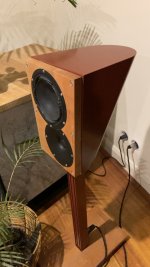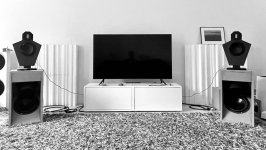Fi25v1 Enclosure Build
Panels’ CAD design was optimized for tongue and groove construction and CNC machining. Panels cut on Tulsa FabLab’s ShopBot.
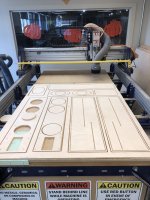
Box and base components.

Careful dimension selections and layout yields low scrap costs.
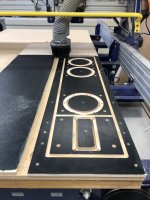
Double layer thick front baffle. Pre painted and sealed panel experiment looking to minimize tear out.
This close-up of the baffle also shows the 38 holes used for the driver and baffle mounting screws. All mounting screws are stainless Allen head machine screws into brass inserts.
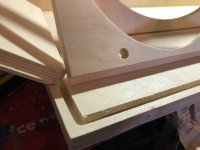
Detail of tongue and groove via CNC.
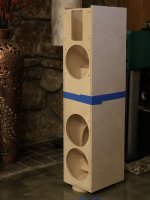
Thanks to tongue and groove build a little masking tape holds the box together for a first look at proportions in the listening room. Top and front baffle not yet cut at this point.
Fi25v1 Enclosure Finishing
The finishing turned into one of those rabbit holes so deep once fallen into (or after jumping headfirst) one can enjoy a nice long existential philosophical conversation with Alice and The Rabbit as we fall and fall and fall. Years of experiments in epoxy finishing led to using pourable epoxy dyed white to cover the sides, top, bottom, and back in a layer up to ¼” thick. Quoting Dickens’ literary classic applied to finishing rather than revolutions, “it was best of times, it was the worst of times”.
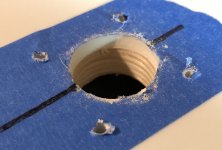
Detail of Speakon connector hole showing epoxy over Birchply construction.
Poured epoxy is a time consuming process, with the epoxy I was using each pour requiring 12-24 hours curing time. After the enclosures’ wood build steps are finished a series of epoxy pours are conduced. Six different pours were planned to epoxy the sides, top, bottom, and backs of the two boxes, front baffles to receive a more conventional finish. This grew to more like ten pours as sides required added build thickness, and for one side a cure failure disaster recovery. Each pour started with the box on a level worktable the edges taped with blue masking tape to form a dam to contain the epoxy. It is important the tape be well adhered or epoxy will leak. Also critical to be very level or the finish will vary in thickness. Should I to ever return to this technique I would add clamped dams backing up the tape and means to better gauge epoxy depth. The uncured epoxy has the viscosity of pancake syrup so it wants to leak and if not thick enough due ti insufficient quantity poured will fail to self-level. If there is interest we can go into more detail in other posts. Once all sides are cured using a router table and flush trim pattern following bit the edges are trimmed. The best part of this finish is how it machines as seen in the photo below. Then a 500 grit disk on random orbit sander took it to exactly the matt finish I had in mind.
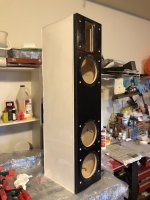
Fi25v1 enclosure with epoxy prior to trimming and sanding.
Test fitting baffle to enclosure after epoxy pours are completed. At this stage the enclosure is encased in epoxy. Next steps edge trimming pours and finish sanding remain.
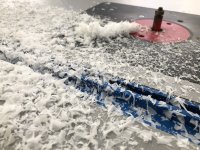
Making chips during the trim and sanding phase.
Pattern following router bit used to trim and flatten panels after which sanding further refine surface and defines the matte finish.
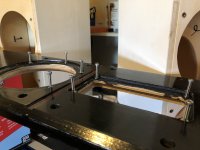
Installing driver threaded inserts, waxed bolts used to keep epoxy off threads.
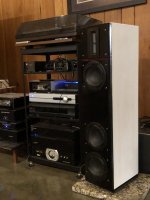
Fi25v1 completed and ready to audition.
Panels’ CAD design was optimized for tongue and groove construction and CNC machining. Panels cut on Tulsa FabLab’s ShopBot.

Box and base components.

Careful dimension selections and layout yields low scrap costs.

Double layer thick front baffle. Pre painted and sealed panel experiment looking to minimize tear out.
This close-up of the baffle also shows the 38 holes used for the driver and baffle mounting screws. All mounting screws are stainless Allen head machine screws into brass inserts.

Detail of tongue and groove via CNC.

Thanks to tongue and groove build a little masking tape holds the box together for a first look at proportions in the listening room. Top and front baffle not yet cut at this point.
Fi25v1 Enclosure Finishing
The finishing turned into one of those rabbit holes so deep once fallen into (or after jumping headfirst) one can enjoy a nice long existential philosophical conversation with Alice and The Rabbit as we fall and fall and fall. Years of experiments in epoxy finishing led to using pourable epoxy dyed white to cover the sides, top, bottom, and back in a layer up to ¼” thick. Quoting Dickens’ literary classic applied to finishing rather than revolutions, “it was best of times, it was the worst of times”.

Detail of Speakon connector hole showing epoxy over Birchply construction.
Poured epoxy is a time consuming process, with the epoxy I was using each pour requiring 12-24 hours curing time. After the enclosures’ wood build steps are finished a series of epoxy pours are conduced. Six different pours were planned to epoxy the sides, top, bottom, and backs of the two boxes, front baffles to receive a more conventional finish. This grew to more like ten pours as sides required added build thickness, and for one side a cure failure disaster recovery. Each pour started with the box on a level worktable the edges taped with blue masking tape to form a dam to contain the epoxy. It is important the tape be well adhered or epoxy will leak. Also critical to be very level or the finish will vary in thickness. Should I to ever return to this technique I would add clamped dams backing up the tape and means to better gauge epoxy depth. The uncured epoxy has the viscosity of pancake syrup so it wants to leak and if not thick enough due ti insufficient quantity poured will fail to self-level. If there is interest we can go into more detail in other posts. Once all sides are cured using a router table and flush trim pattern following bit the edges are trimmed. The best part of this finish is how it machines as seen in the photo below. Then a 500 grit disk on random orbit sander took it to exactly the matt finish I had in mind.

Fi25v1 enclosure with epoxy prior to trimming and sanding.
Test fitting baffle to enclosure after epoxy pours are completed. At this stage the enclosure is encased in epoxy. Next steps edge trimming pours and finish sanding remain.

Making chips during the trim and sanding phase.
Pattern following router bit used to trim and flatten panels after which sanding further refine surface and defines the matte finish.

Installing driver threaded inserts, waxed bolts used to keep epoxy off threads.

Fi25v1 completed and ready to audition.
Fi25v1 Measurements
Measurements were made with B&K 4004 microphones, E-MU 0404 ADC @ 96k/24bits, and REW software running on WIN10. As a relatively new REW user I mistakenly left all the phase displays turned on in the following graphs on. The amplitude vs. frequency graphs is in each case the top trace.
The first two graphs show near field responses taken 1 foot in front of each Fi25v1 speaker with microphone at tweeter height. The simple 24dB/octive electronic crossover at 3k Hz needs some work as evidenced by the dip at 3k. Above that the NEO CD2.0 tweeter is so smooth. Below crossover the PTT6.5 woofer is also smooth extends to 30 Hz. I wonder if the step down below 200 Hz is the extended bass shelf response or just a measurement artifact?
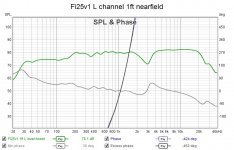
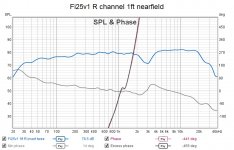
The two ‘couch’ response graphs are room response graphs taken at the listening position a couch which sites the listener 3 feet from the back wall and 15 feet from the speakers. With room gain and modes included its apparent how much energy the PTT6.5 woofer and passive radiators can pump into my room.
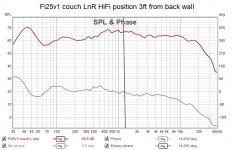
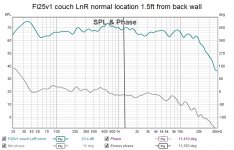
Measurements were made with B&K 4004 microphones, E-MU 0404 ADC @ 96k/24bits, and REW software running on WIN10. As a relatively new REW user I mistakenly left all the phase displays turned on in the following graphs on. The amplitude vs. frequency graphs is in each case the top trace.
The first two graphs show near field responses taken 1 foot in front of each Fi25v1 speaker with microphone at tweeter height. The simple 24dB/octive electronic crossover at 3k Hz needs some work as evidenced by the dip at 3k. Above that the NEO CD2.0 tweeter is so smooth. Below crossover the PTT6.5 woofer is also smooth extends to 30 Hz. I wonder if the step down below 200 Hz is the extended bass shelf response or just a measurement artifact?


The two ‘couch’ response graphs are room response graphs taken at the listening position a couch which sites the listener 3 feet from the back wall and 15 feet from the speakers. With room gain and modes included its apparent how much energy the PTT6.5 woofer and passive radiators can pump into my room.


Fi25v1 Listening
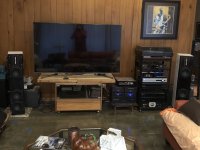
The audible success of the Fi16v1 led to the commitment of resources into the Fi25v1 tower build. As the saying goes the proof of the pudding is in the eating, our corollary here the proof of the speaker the listening. By that criteria Fi25 is a success. As of writing this project report many 10s even 100s of hours of listening by myself and friends yielded unanimous praise. The audible transparency Purifi brings to the game is now a given in my listening room, this holds for both the 16L and 25L configurations. Like the Fi16 the Fi25s reset bass performance yielding in these décor friendly compact sizes the effortless slam and extension one normally associates with 12” or 15” drivers in refrigerator sized enclosures. I will be honest with my friends here on diyaudio.com that any hoped for ‘awsome’ stepwise decent into massive subbass did not materialize. Comparing the 16 liter vs. 25 liter enclosures one is hard pressed to notice the larger enclosure as presently configured adding to the already state of the art bass depth, low distortion, dynamic linearity and ‘startle factor’ Purifi brings to the party.
Testing with sine waves also reveals a liability the 25L tower enclosure brings the 16L boxes avoid. At 20 Hz the dual passive radiators go out of phase with each other. It is rather alarming watching as one is clearing moving forward and the other backwards each with several mm amplitude. Of course power handling plummets as the active driver finds itself unloaded by the enclosure system. Physics can be a bitch. Despite massive market popularity of slender tower enclosures they do behave like organ pipes. At 20 Hz the wavelength is 17 METERS(!) vs the 95 cm of this box. So rather than a fully developed wave (which does not fit in the box) one gets pressure pulses rolling down from the active driver to the pair of passive radiators. These pressure pulses encounter the radiators at different times so at some frequencies they can go out of phase. Loop back to the conceptual phase of my design and placing the active driver and radiators all on the front of the baffle was part of the industrial design process. If one is spending the bucks on these units have them on show is the thinking. And personally for causal listening in my room the speakers are moved closer to the back wall so all active drivers on the front seemed like a good idea.
The interesting, at least to me its interesting, finding is with music as source with purely subjective listening this liability is not noticed. Only when stepping or sweeping through pure sine waves does it become suddenly quite apparent.
The present conclusion is when using PTT6.5W with 2 each PTT6.5PR passive radiators I will suggest sticking with enclosure sizes in the 15-16L range. The 25L experiment / journey tended to confirm smaller in this case is better, a Fi16v3 variant is completed and ready to share shortly. I may well return to the 25L box replacing the PRs with ports to explore if one port avoids the position effects the dual PRs suffered as pressure pulses traverse a tower shaped box. Any Fi25v2 is queued up behind several other projects that in my judgement offer better chances for moving the HiFi performance and musical enjoyment obtained with Purifi drivers to an even higher state of the art. The other good news is while exploring these sometimes esoteric paths the basic 15 to 16 liter two way remains so fracking good.

The audible success of the Fi16v1 led to the commitment of resources into the Fi25v1 tower build. As the saying goes the proof of the pudding is in the eating, our corollary here the proof of the speaker the listening. By that criteria Fi25 is a success. As of writing this project report many 10s even 100s of hours of listening by myself and friends yielded unanimous praise. The audible transparency Purifi brings to the game is now a given in my listening room, this holds for both the 16L and 25L configurations. Like the Fi16 the Fi25s reset bass performance yielding in these décor friendly compact sizes the effortless slam and extension one normally associates with 12” or 15” drivers in refrigerator sized enclosures. I will be honest with my friends here on diyaudio.com that any hoped for ‘awsome’ stepwise decent into massive subbass did not materialize. Comparing the 16 liter vs. 25 liter enclosures one is hard pressed to notice the larger enclosure as presently configured adding to the already state of the art bass depth, low distortion, dynamic linearity and ‘startle factor’ Purifi brings to the party.
Testing with sine waves also reveals a liability the 25L tower enclosure brings the 16L boxes avoid. At 20 Hz the dual passive radiators go out of phase with each other. It is rather alarming watching as one is clearing moving forward and the other backwards each with several mm amplitude. Of course power handling plummets as the active driver finds itself unloaded by the enclosure system. Physics can be a bitch. Despite massive market popularity of slender tower enclosures they do behave like organ pipes. At 20 Hz the wavelength is 17 METERS(!) vs the 95 cm of this box. So rather than a fully developed wave (which does not fit in the box) one gets pressure pulses rolling down from the active driver to the pair of passive radiators. These pressure pulses encounter the radiators at different times so at some frequencies they can go out of phase. Loop back to the conceptual phase of my design and placing the active driver and radiators all on the front of the baffle was part of the industrial design process. If one is spending the bucks on these units have them on show is the thinking. And personally for causal listening in my room the speakers are moved closer to the back wall so all active drivers on the front seemed like a good idea.
The interesting, at least to me its interesting, finding is with music as source with purely subjective listening this liability is not noticed. Only when stepping or sweeping through pure sine waves does it become suddenly quite apparent.
The present conclusion is when using PTT6.5W with 2 each PTT6.5PR passive radiators I will suggest sticking with enclosure sizes in the 15-16L range. The 25L experiment / journey tended to confirm smaller in this case is better, a Fi16v3 variant is completed and ready to share shortly. I may well return to the 25L box replacing the PRs with ports to explore if one port avoids the position effects the dual PRs suffered as pressure pulses traverse a tower shaped box. Any Fi25v2 is queued up behind several other projects that in my judgement offer better chances for moving the HiFi performance and musical enjoyment obtained with Purifi drivers to an even higher state of the art. The other good news is while exploring these sometimes esoteric paths the basic 15 to 16 liter two way remains so fracking good.
Awesome job!
Regarding the out of phase dual PRs, do you think a larger single unit would perform better where that situation occurs? I'm planning on a 22 liter build, stuffed to approximate 25 liters, and was looking at the Seas 8" PR. Any thoughts on that combo?
Regarding the out of phase dual PRs, do you think a larger single unit would perform better where that situation occurs? I'm planning on a 22 liter build, stuffed to approximate 25 liters, and was looking at the Seas 8" PR. Any thoughts on that combo?
Attachments
Hi Norman,
I would also think that 25L box brings us more into port territory. As the box size goes up, the mass of the PR goes down to reach the same box tuning frequency fb. As the mass of the PR goes down, then its free field resoance goes up and at this frequency we have a far field cancellation notch due to the PR and active driver 180 degree out of phase. The port has the advange of only being a mass plug with infinite compliance )no restoring spring force) and ehrefore a ported box does not have the cancellation notch and only gives a 4th order response compared to the 5th order response of the PR system. The PR is great is a small box since here, the port would get excessively long and the high mass loading on the PR moves the notch down.
Cheers,
Lars (Purifi)
I would also think that 25L box brings us more into port territory. As the box size goes up, the mass of the PR goes down to reach the same box tuning frequency fb. As the mass of the PR goes down, then its free field resoance goes up and at this frequency we have a far field cancellation notch due to the PR and active driver 180 degree out of phase. The port has the advange of only being a mass plug with infinite compliance )no restoring spring force) and ehrefore a ported box does not have the cancellation notch and only gives a 4th order response compared to the 5th order response of the PR system. The PR is great is a small box since here, the port would get excessively long and the high mass loading on the PR moves the notch down.
Cheers,
Lars (Purifi)
While I was writing the following Lars from Purifi kindly commented on the Fi25v1 design. His insights certainly move my idea that a Fi25v2 be tried changing PRs out to a port up higher in the project queue.
Thank you Lars for the input.
Given Lars explanation to the following discussion of PRs for Haze Head’s design one adds the decision point of should Haze go as planned with SP22 PR or a port?
Haze Head asks “Regarding the out of phase dual PRs, do you think a larger single unit would perform better where that situation occurs?...”.
Compared to experience with vented and sealed types I am a new (and thus far enthusiastic) user of passive radiators. Weight the following accordingly as we learn together.
The Fi16v3 variant mentioned above uses a single SB Acoustics 5”x 8” SB15SFCR-00 PR in 16 liters to quite good effect. The Seas you propose also looks like a good candidate. There is the design rule guideline that the Effective piston area of the PR(s) should be 2x the woofer being loaded. The PTT6.5W and matching PTT6.5PR area is specified as 133 cm squared. The SP SB15SFCR-00 PR is 178 cm squared and SEAS SP22R H9945 is 230 cm squared. So the SP22 is just shy of the ideal 266 cm squared for only $68 (in USA from Madisound) that looks like an excellent choice. I would expect the SP22 to keep up longer with my one SB Acoustics 5”x 8”. Personally I believe when the budget allows use the PTT6.5PR to enjoy the goodness its surround and soft parts bring.
So that leaves the organ pipe effect I encountered. Next time I would place the PR or PRs closer to the woofer aiming to keep the woofer and PR in the same pressure zone of any resonances that develop. I also plan to experiment with acoustic resistances in the enclosure like a panel full of holes or heavy stuffing midway along the long direction. Perhaps your planned “22 liter build, stuffed to approximate 25 liters” will provide that resistive damping to break up (or more likely attenuate) the standing wave that bedeviled the Fi25v1 during testing?
Thank you Lars for the input.
Given Lars explanation to the following discussion of PRs for Haze Head’s design one adds the decision point of should Haze go as planned with SP22 PR or a port?
Haze Head asks “Regarding the out of phase dual PRs, do you think a larger single unit would perform better where that situation occurs?...”.
Compared to experience with vented and sealed types I am a new (and thus far enthusiastic) user of passive radiators. Weight the following accordingly as we learn together.
The Fi16v3 variant mentioned above uses a single SB Acoustics 5”x 8” SB15SFCR-00 PR in 16 liters to quite good effect. The Seas you propose also looks like a good candidate. There is the design rule guideline that the Effective piston area of the PR(s) should be 2x the woofer being loaded. The PTT6.5W and matching PTT6.5PR area is specified as 133 cm squared. The SP SB15SFCR-00 PR is 178 cm squared and SEAS SP22R H9945 is 230 cm squared. So the SP22 is just shy of the ideal 266 cm squared for only $68 (in USA from Madisound) that looks like an excellent choice. I would expect the SP22 to keep up longer with my one SB Acoustics 5”x 8”. Personally I believe when the budget allows use the PTT6.5PR to enjoy the goodness its surround and soft parts bring.
So that leaves the organ pipe effect I encountered. Next time I would place the PR or PRs closer to the woofer aiming to keep the woofer and PR in the same pressure zone of any resonances that develop. I also plan to experiment with acoustic resistances in the enclosure like a panel full of holes or heavy stuffing midway along the long direction. Perhaps your planned “22 liter build, stuffed to approximate 25 liters” will provide that resistive damping to break up (or more likely attenuate) the standing wave that bedeviled the Fi25v1 during testing?
Thank you, Norman. Considering your impression of the 25L version compared to the 16L build, I combed through the entire thread to get a general idea of each build. It looks like ~16L is about the smallest, with ~25L being the largest.
Most builds implemented PRs. Plus one TL and one ported. Based on the comment Lars made on port territory, as well as your recent experience, I'm thinking there are two sensible avenues. One being to reduce the volume and proceed with PRs. Or, stay with the larger version and go ported/TL. I've been attracted to PRs from the construction simplicity standpoint. And as you mention, the SEAS PR is a very economical solution.
I hope that you can get some time to implement one or more of the tweaks discussed in regards to PRs vs a port implementation. Currently you have the only floor-standing build on this thread and the results are especially interesting thanks to the contrast of your previous build.
Here is what I came up with for current PURIFI builds (this thread) just to provide a snapshot of what everyone has tried thus far:
Build 1
mainframe99
Volume: ?
Build 2
Norman Tracy
Volume: 16L PR
Build 3
xrk971
Volume: ?
Build 4
jmpsmash
Volume: ~21L
Build 5
mainframe99
Volume: ?
Build 6
xrk971
Volume: ~25L TL
Build 7
mainframe99
Volume: ?
Build 8
tktran303
Volume: 19.5L Ported
Build 9
Norman Tracy
Volume 25L PR
Most builds implemented PRs. Plus one TL and one ported. Based on the comment Lars made on port territory, as well as your recent experience, I'm thinking there are two sensible avenues. One being to reduce the volume and proceed with PRs. Or, stay with the larger version and go ported/TL. I've been attracted to PRs from the construction simplicity standpoint. And as you mention, the SEAS PR is a very economical solution.
I hope that you can get some time to implement one or more of the tweaks discussed in regards to PRs vs a port implementation. Currently you have the only floor-standing build on this thread and the results are especially interesting thanks to the contrast of your previous build.
Here is what I came up with for current PURIFI builds (this thread) just to provide a snapshot of what everyone has tried thus far:
Build 1
mainframe99
Volume: ?
Build 2
Norman Tracy
Volume: 16L PR
Build 3
xrk971
Volume: ?
Build 4
jmpsmash
Volume: ~21L
Build 5
mainframe99
Volume: ?
Build 6
xrk971
Volume: ~25L TL
Build 7
mainframe99
Volume: ?
Build 8
tktran303
Volume: 19.5L Ported
Build 9
Norman Tracy
Volume 25L PR
For information, if you have not read it, in its latest review Hificompass says:
"To my recommendations for the use of PTT6.5W04-01A, I would like to add that after extensive testing of both 4-ohm and 8-ohm models in the "Passive radiator" type loudspeaker enclosures with an internal volume of 12 to 20 liters, the most optimal sound is obtained in volume 14-15 liters. In this case the optimal balance is achieved between the depth of the bass and its energy, density, elasticity and punch. At 20 liters it becomes very deep, but sluggish, and at 12 liters it is already dry."
Based on its reviews and multiple projects with purifi, I think it is a solid recommandation.
"To my recommendations for the use of PTT6.5W04-01A, I would like to add that after extensive testing of both 4-ohm and 8-ohm models in the "Passive radiator" type loudspeaker enclosures with an internal volume of 12 to 20 liters, the most optimal sound is obtained in volume 14-15 liters. In this case the optimal balance is achieved between the depth of the bass and its energy, density, elasticity and punch. At 20 liters it becomes very deep, but sluggish, and at 12 liters it is already dry."
Based on its reviews and multiple projects with purifi, I think it is a solid recommandation.
He definitely has a wealth of good info on his builds @ nanou64000. To keep on the safe side, that recommended range does make sense. I feel like working with the PTT6 is like getting a hold of a Ferrari and then realizing that tapping the capabilities comes with its own unique set of challenges. But knowing that it is a Ferrari, you want to do everything possible to let it rip.
Over the last 24hrs I've become inclined to reduce a ported build from 25L to 21-22L, or, do a PR build in the 14-16L range. So, a definite change in strategy for me at this point.
Over the last 24hrs I've become inclined to reduce a ported build from 25L to 21-22L, or, do a PR build in the 14-16L range. So, a definite change in strategy for me at this point.
18L ported and 8l sealed tested
I toyed with an 18l enclosure I had, ported it and made a baffle for the purifi and Viseton KE25 tweeters. I found I still wanted to use subs as the weight in the lows wasn't what I was looking for. Given that I have two 15" subs in stereo I decided to trade off the bottom 100hz and gain a less imposing small box so I built some sealed aluminium enclosures as shown. Electronic crossover at 2000 and 100 and I have the best imaging and detail I have ever heard let alone had. The tweeter measures a bit ugly down this low so I may try to take the Purifi up to 2200 as tweak.
I toyed with an 18l enclosure I had, ported it and made a baffle for the purifi and Viseton KE25 tweeters. I found I still wanted to use subs as the weight in the lows wasn't what I was looking for. Given that I have two 15" subs in stereo I decided to trade off the bottom 100hz and gain a less imposing small box so I built some sealed aluminium enclosures as shown. Electronic crossover at 2000 and 100 and I have the best imaging and detail I have ever heard let alone had. The tweeter measures a bit ugly down this low so I may try to take the Purifi up to 2200 as tweak.
Attachments
Is that the 148 R waveguide?I toyed with an 18l enclosure I had, ported it and made a baffle for the purifi and Viseton KE25 tweeters. I found I still wanted to use subs as the weight in the lows wasn't what I was looking for. Given that I have two 15" subs in stereo I decided to trade off the bottom 100hz and gain a less imposing small box so I built some sealed aluminium enclosures as shown. Electronic crossover at 2000 and 100 and I have the best imaging and detail I have ever heard let alone had. The tweeter measures a bit ugly down this low so I may try to take the Purifi up to 2200 as tweak.
It its the Visaton waveguide to suit that tweeter. I can't recall the number but will take a look through my paperwork over the weekend and confirm.
I’d like to share some of the things I’ve learnt whilst building a speaker with the Purifi 6.5TT (original 4ohm version)
1a) Box Modelling only get me so close. My original box of 20L modelled as Fb of 39Hz.
When it was all done, deadened and stuffed, it measured at 35Hz.
1b) Simulated port length is longer than actual port length needed. My simulator
recommend 2.5” x 12” port, which I wondering how I would fit into the cabinet.
It turns out I only needed a 2.5” x 8.5” port So don’t be afraid to build a few boxes as test mules.
2. The room makes such a big difference in the bass. And probably swamps any minor differences in port tuning I was obsessed about hitting. Don’t be afraid to use a port that you can shorten or lengthen, (or add weight to your passive radiator)
1a) Box Modelling only get me so close. My original box of 20L modelled as Fb of 39Hz.
When it was all done, deadened and stuffed, it measured at 35Hz.
1b) Simulated port length is longer than actual port length needed. My simulator
recommend 2.5” x 12” port, which I wondering how I would fit into the cabinet.
It turns out I only needed a 2.5” x 8.5” port So don’t be afraid to build a few boxes as test mules.
2. The room makes such a big difference in the bass. And probably swamps any minor differences in port tuning I was obsessed about hitting. Don’t be afraid to use a port that you can shorten or lengthen, (or add weight to your passive radiator)
Last edited:
Agree, I had half my port outside the cabinet. I had a plan to build it into the stand but decided that I would probably never be happy with the bass so handed over to subs and decided I may as well go to a small sealed box given I am not chasing the very lows. I am thinking the next logical thing for my direction is the new 4.5" PTT.
BTW I chose the 8ohm PTT6.5 as I have dedicated amp for it and looking for a more friendly load.
BTW I chose the 8ohm PTT6.5 as I have dedicated amp for it and looking for a more friendly load.
While I was writing the following Lars from Purifi kindly commented on the Fi25v1 design. His insights certainly move my idea that a Fi25v2 be tried changing PRs out to a port up higher in the project queue.
Thank you Lars for the input.
Given Lars explanation to the following discussion of PRs for Haze Head’s design one adds the decision point of should Haze go as planned with SP22 PR or a port?
Haze Head asks “Regarding the out of phase dual PRs, do you think a larger single unit would perform better where that situation occurs?...”.
Compared to experience with vented and sealed types I am a new (and thus far enthusiastic) user of passive radiators. Weight the following accordingly as we learn together.
The Fi16v3 variant mentioned above uses a single SB Acoustics 5”x 8” SB15SFCR-00 PR in 16 liters to quite good effect. The Seas you propose also looks like a good candidate. There is the design rule guideline that the Effective piston area of the PR(s) should be 2x the woofer being loaded. The PTT6.5W and matching PTT6.5PR area is specified as 133 cm squared. The SP SB15SFCR-00 PR is 178 cm squared and SEAS SP22R H9945 is 230 cm squared. So the SP22 is just shy of the ideal 266 cm squared for only $68 (in USA from Madisound) that looks like an excellent choice. I would expect the SP22 to keep up longer with my one SB Acoustics 5”x 8”. Personally I believe when the budget allows use the PTT6.5PR to enjoy the goodness its surround and soft parts bring.
So that leaves the organ pipe effect I encountered. Next time I would place the PR or PRs closer to the woofer aiming to keep the woofer and PR in the same pressure zone of any resonances that develop. I also plan to experiment with acoustic resistances in the enclosure like a panel full of holes or heavy stuffing midway along the long direction. Perhaps your planned “22 liter build, stuffed to approximate 25 liters” will provide that resistive damping to break up (or more likely attenuate) the standing wave that bedeviled the Fi25v1 during testing?
just wonder why most people are thinking single passive radiator instead of using dual (e.gSB Acoustics SB16PFCR-00 ) ? is dual harder to implement whe wieght is taking into account ?
I think most ppl are actually using 2 PRs.just wonder why most people are thinking single passive radiator instead of using dual (e.gSB Acoustics SB16PFCR-00 ) ? is dual harder to implement whe wieght is taking into account ?
I toyed with an 18l enclosure I had, ported it and made a baffle for the purifi and Viseton KE25 tweeters. I found I still wanted to use subs as the weight in the lows wasn't what I was looking for. Given that I have two 15" subs in stereo I decided to trade off the bottom 100hz and gain a less imposing small box so I built some sealed aluminium enclosures as shown. Electronic crossover at 2000 and 100 and I have the best imaging and detail I have ever heard let alone had. The tweeter measures a bit ugly down this low so I may try to take the Purifi up to 2200 as tweak.
Well done so far!
Purifi - The Bat Open Baffle Edition
During my build process of Purifi SPK5 using the excellent Viawave GRT145 ribbon tweeter I had to try the Purifi 6.5" and Viawave tweeter in an open baffle together with the Linkwitz LXsub (for my LX521.4 build...)
Crossover is LR24 @2.0kHz.
During my build process of Purifi SPK5 using the excellent Viawave GRT145 ribbon tweeter I had to try the Purifi 6.5" and Viawave tweeter in an open baffle together with the Linkwitz LXsub (for my LX521.4 build...)
Crossover is LR24 @2.0kHz.
Attachments
Agree, I had half my port outside the cabinet. I had a plan to build it into the stand but decided that I would probably never be happy with the bass so handed over to subs and decided I may as well go to a small sealed box given I am not chasing the very lows. I am thinking the next logical thing for my direction is the new 4.5" PTT.
BTW I chose the 8ohm PTT6.5 as I have dedicated amp for it and looking for a more friendly load.
What new 4.5?
- Home
- Loudspeakers
- Multi-Way
- Exploring Purifi Woofer Speaker Builds
